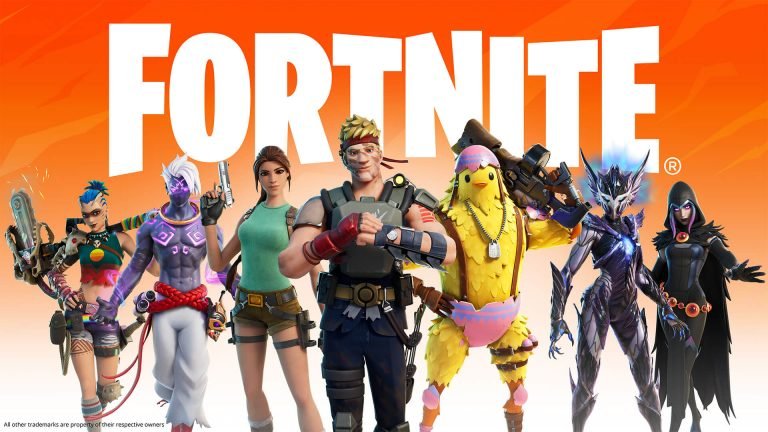
What is Fortnite and how can I talk with my child about the game?
Rebecca on Oct. 23, 2024
Is Fortnite sus and how can I talk with my child about the game?
Are you wondering whether Fortnite is appropriate for your child? In New Zealand Fortnite doesn’t have a local classification but it does have an Australian gaming rating of M with content warnings for violence and online interactivity.
My nine-year-old is a gamer, and he’s really good at any game that takes his interest. We held off letting him play Fortnite for as long as possible because it has a recommended age of 12+. With some agreed time limitations and rules, such as only playing in the shared living space, and only adding approved friends, we’ve made this game age-appropriate for our gaming son.
In this blog we discuss a lot about this popular online game. We've broken this information down into the following sections:
What do the kids say about the game?
What is Fortnite, how does it work?
What do we as Classification Advisors say about it?
Does it have a classification in New Zealand?
Are parental controls an option?
What do the kids say about the game?
“Fortnite is fun! It’s interactive with quests, missions, and bounties to hunt in-game.”
You can set restrictions for different ages, so lots of different game options depending on how old you are.
The game involves shooting other players, but there’s no blood, and if a player is eliminated they can be ‘regenerated’ by their team. Players take their fallen team mate to the reboot van with a reboot card, and the player can re-join the match. When you “regen” (regenerate) your team mate makes a celebration sound. If you turn on ‘team voice chat’ then you can chat with those people in your team – including randoms – or you can turn on ’friends only chat’.
There are different lobbies with different objectives like:
- Battle Royale is the main variation of the game. It’s a third-person shooter game, but when you aim the view goes into first person. It’s when you drop down out of a bus flying in the sky and you jump out and glide to your chosen drop point. You hunt for loot chests that have weapons and bonus items, and then you fight people. You fight to be the last person standing. In the lobby before the battle starts you choose to fight as a Solo, with friends, or team up in a squad with randoms (“no fill” or “fill”). Fill means you allow the game to allocate a random person to fill your team from the online environment.
- Red vs Blue –a game where you’re in an arena, you select guns from a cabinet, you then hunt other players and collect coins when you kill them. More coins allow you to buy better weapons.
- Special events – like Day of Doom chapter 5 season 4 you’re either chosen as a henchmen or a hero with different goals in the game play. In this version of the special event Doctor Doom is practically invincible and has 500 health + 500 shield + 200 syphon (when you kill people you gain health). Doctor Doom can usually only beaten by everyone teaming up against them.
“It’s a fun game. It’s not pay to win, it’s based on skill. It has topics that I like battle royale fighting to be last person standing, and driving game which is fun and relaxing” - Master H, nearly 10 years old.
*Hot tip for parents: When your child says they're playing 'Fortnite', ask them what lobby they're playing in as the game play varies between lobbies.
What is Fortnite, how does it work?
Master H is right, Fortnite is an online game that involves strategy and team work for survival. Its most popular mode is Battle Royale, a multiplayer shooting game where the aim is to be the last one standing out of 100 players who are ‘dropped’ onto an island. You collect loot, use a map to explore and hide, and you can regenerate players who have been ‘eliminated’. A storm forces the map to get smaller and smaller as the game continues forcing players together.
There are different game modes and experiences to choose from. While Fortnite is a competitive game, it uses pro-social systems to encourage players to co-operate towards a common goal.
Players have the option of purchasing additional items such as skins (outfits) and weapons. This is an appealing part of the game, being able to differentiate your character from others. You need V-Bucks currency, which is purchased using real money.
Weapons are cartoonish. They’re modelled on pistols, snipers, SMGs (rapid fire guns), shotguns, rocket rams and more but are not realistic and often fire laser beams, electric waves etc.

What do we (Classification Advisors) say about it?
The game is suitable for older children and teenagers. The international game rating recommends for ages 12+ but with the use of parental controls you may find younger players in your whānau can comfortably enjoy the game play. The overall PEGI (Pan-European Game Information) age rating is 12. We don’t classify the game in New Zealand because it is an online-only game.
Does it have a classification in New Zealand?
Fortnite is an online game, and does not have a NZ classification. Each game under the Fortnite umbrella has been given international gaming age ratings. Fortnite has an international gaming age rating of PEGI 12 / ESRB Teen in the US. Fortnite as a whole has the PEGI rating of Parental Guidance. You can read more about international game classifications here.
Are parental controls an option?
Epic Games have parental control options for Fortnite. Set up parental controls within Fortnite by selecting your Player Icon and then Menu Icon. You’ll need to link the account to a parent email address, and then set up a 6-digital Parental Controls PIN.
Epic Games’ parental controls include managing your child’s online social interactions (voice chat and text chat permissions), filter mature language, require a PIN to add friends, and make purchases. You can set limits for total time spent in Fortnite, and whether they can request more time.
There are also parental control options depending on the gaming console being used for game play. Our parental controls resource outlines the popular console parental control options.
Fortnite content ratings
Every experience in Fortnite has an age rating. You can restrict access based on your child’s age. A parental control PIN is required to unlock experiences above the age-rating you have set.
Cabined accounts
Epic provide a type of account for younger players (under 13) that requires parental consent to access some content or features in Fortnite. Features disabled included communicating with other players (voice or free text chat), purchasing items, downloading games. Learn more about Cabined accounts with Epic.
While you’re here just be aware
Fortnite has become a social hub for millions of players, including many kids. Over 60% of players on Fortnite are between 18-24, and almost 90% are male.
Here’s a quick look at the potential risks, plus tips on how to deal with them and keep your child safe while they enjoy the game. Note that many of these risks apply not just to gaming environments. Keep these in mind for you and your rangatahi and their offline and online world experiences.
Netsafe have a gaming toolkit which is a great resource for parents and whānau.
Cartoon Violence
Fortnite is famous for its bright, cartoonish style – which makes the violence less graphic compared to other shooter games. But keep in mind, the goal of many game modes is still to be the last one standing, which means shooting opponents. The violence may not involve blood or gore, but it's still there.
What parents can do:
- Use parental controls to manage what game modes your child plays.
- Have open conversations about the difference between virtual violence and real-life actions.
- Guide them towards less violent, more social game modes.
Inappropriate Language
Fortnite’s chat feature can be a minefield of offensive language, especially in the popular Battle Royale mode. With a majority of players between 18-24 years old, there's a chance kids could hear mature content, from profanity to inappropriate discussions.
What parents can do:
- Set permissions to control friend requests, voice, and text chat.
- Consider ‘no headphones’ as rule so you can keep an ear out for who they’re chatting with.
- Use filters to block offensive language, or turn off the chat altogether for younger kids.
Online Predators
The open chat system in Fortnite means that strangers can sometimes interact with your child, and some of these strangers might not have the best intentions. Grooming by online predators is a real risk. Netsafe provide guidance if you suspect your young person is being groomed online.
What parents can do:
- Teach your child about online safety, including how to block and report suspicious users.
- Monitor who they are playing with and be involved in their online interactions.
- Read our tips on how to talk with young people about what they’re watching.
Scams
Kids can sometimes be tricked into spending money in games, either through scams or pressure from other players. Online platforms like Fortnite can offer opportunities for in-game purchases, and some scammers try to take advantage of that.
On the platform this could look like players being scammed by others into buying items for them using V-Bucks or gifting their purchases. It's important for parents to be aware and have conversations with their children about this.
Off the platform it could be scams aimed at increasing traffic to other platforms, such as free V-Bucks code videos that direct viewers to Twitch or YouTube. While a few may be legitimate, many are scams designed to profit from the traffic to their accounts. Parents should also be aware of these scams.
Netsafe provide resources about fake prize and competition scams in games, in-app purchases on mobile games and general advice about understanding scams.
What parents can do:
- Set up parental controls that require a password for purchases.
- Discuss the importance of protecting their account and not sharing financial info.
Stress and anxiety
Fortnite is fast-paced, and that can sometimes trigger your child’s fight-or-flight response – leading to adrenaline spikes and heightened stress levels.
This 2017 research looked at violent video game effects on children (ScienceDirect)
What parents can do:
- Set limits on game time to make sure they get breaks and can relax.
- Encourage physical activity and other interests to balance out screen time.
Watching Fortnite Livestreams
A lot of kids aren’t just playing Fortnite, they’re watching others play on platforms like Twitch. While this can be entertaining, it can also expose them to inappropriate content. Netsafe provide tips and resources about online gaming.
What parents can do:
- Keep an eye on who they’re watching on Twitch or YouTube.
- If your child wants to livestream, talk to them about the risks involved.
Cyberbullying
Like many multiplayer games, Fortnite has its share of cyberbullies. The competitive nature of the game can lead to some players taking out their frustrations on others through harassment or trash talk. Read more on Netsafe’s resource about cyberbullying.
What parents can do:
- Check your child's default privacy settings — for players under 18, it should show that their chat is set to "Nobody," profiles are hidden, parties are "Invite Only," and personalized recommendations are off. For players under 16, the mature language filter should also be turned on.
- Show your child how to mute, block, or report players who are being mean or inappropriate.
- Monitor their gameplay and step in if you notice any signs of bullying.
Considerations for Neurodivergent Kids
For kids with ADHD or other neurodivergent conditions, Fortnite can sometimes lead to hyperfocus, making it hard to step away from the game. The quick pace and constant rewards can make it especially tough for impulsive children.
What parents can do:
- Set clear rules about how much game time is allowed and stick to them.
- Use parental controls to avoid in-game purchases.
- Be open to their excitement about Fortnite while maintaining boundaries.
Off-Platform Communication
Many kids use other platforms like Discord to chat with friends—or even strangers—while playing Fortnite. This can make it harder for parents to monitor what’s happening, as these platforms may have different privacy settings. Strangers can build trust with kids in Fortnite, then move the conversation to another less secure platform.
What parents can do:
- Make sure you’re aware of what platforms your child is using outside of Fortnite.
- Set up privacy controls on platforms like Discord and show your child how to block or report users.
- Talk to your child about the risks of chatting with strangers online.
- Make sure they know not to share personal information and let them know they can always come to you if something feels off.
Final thoughts and further reading
Fortnite can be fun, but it’s important to stay aware of the potential risks. You’re a great parent, we know because you read this far! By using parental controls, setting clear boundaries, and maintaining open communication, you can help keep your child safe while they play. Don’t hesitate to join them in the game – understanding how it works can make it easier to guide them toward safer, more positive experiences.
Further reading
Keeping it safe in the gaming space (blog)
Understanding loot boxes: a guide for parents and whānau (blog)
Game on: Our guide to understanding international gaming classifications (blog)
Entertainment Software Rating Board: A parents guide to Fortnite (blog)
Fortnite to feature International Age Rating Coalition assigned ratings (Epic Games)
Advice for young people online gaming (Netsafe)
Why do kids with ADHD get hooked on Fortnite? (Additude magazine)
Is Fortnite Bad for Kids? Effects of Violent Video Games (psychcentral.com)
Subscribe to our blog
Stay up to date with the Classification Office blog.


